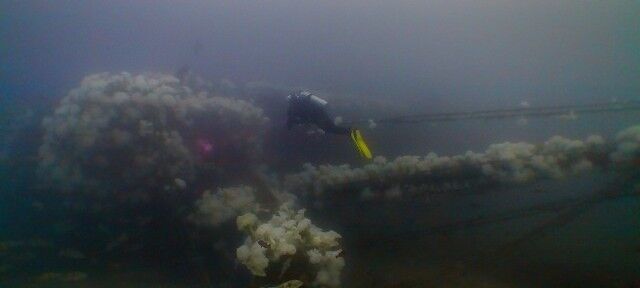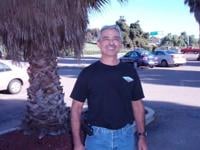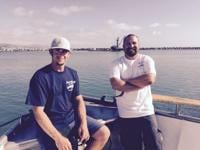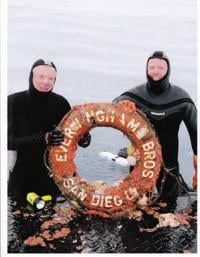On the 10th anniversary of the sinking of the A.C.E. the story of how the wreck was discovered is told

Since sinking on Nov. 26, 2005, the A.C.E. has become a healthy artificial reef, attracting a wide variety of sea life. Photo: Boonchob Vijarnsorn
By Scott Marshutz, special to the San Clemente Times
[dropcap]N[/dropcap]early two years after Dana Point’s bait hauler went down in wind-whipped waters off the coast of San Clemente, Chad Steffen was taking a group of anglers out on the San Mateo, one of several boats in Dana Warf’s Sportfishing fleet. It was June 2007.
“During the summer, we’ll head down the coast for a day trip and fish the typical spots,” Steffen explained. “As a fleet, we’re going to swing to the outside a little bit, to a depth range of 90 to 240 feet. Sometimes we’ll stagger ourselves as we’re looking for fish coming up from Baja.”
As captain, Steffen watched his fathometer closely as the San Mateo motored a few miles out of the Dana Point Harbor.
“We ran over an edge of something where there was a solid indication of fish,” he said. “I turned the boat around and came back to try to find it again and the second time I was thinking ‘what the heck is this?’ Considering the time of year, I was also thinking it could be a really concentrated ball of sand bass. We anchored on it and immediately started catching sand bass, but then we started catching rockfish too, which are structure fish—you’re not going to find them out in the mud.
“I’ve been fishing these areas for several years and I knew there was no structure down there so it had to be something new. That’s when I thought it was probably the A.C.E. and wrote the coordinates down.”

Former A.C.E. captain Robert Machado. Photo: Scott Marshutz
Early in the morning on Nov. 26, 2005, the A.C.E., a 58-foot drum seiner, was en route to the Dana Point Harbor after a night of bait fishing. Offshore winds, which kicked up a sharp and quick chop producing vertically shaped waves breaking only seconds apart, slammed the boat relentlessly until it finally capsized; the vessel was already listing from a leaking deck hatch.
Because it flipped so quickly, the crew was unable to grab any life jackets. The emergency radio beacon failed to send a signal to the Coast Guard and the life raft failed to automatically inflate.
Amazingly, captain Robert Machado and all three crewmembers survived without serious injury and were able to swim to the 14-foot skiff the A.C.E. was towing and shot off emergency flares. San Clemente resident Ed Westberg spotted the red sparks from his ocean-view home around 3 a.m. and called the Harbor Patrol. With Westberg’s help, the two deputies located the skiff before it was dragged under. Accounts of the dramatic rescue were widely published.
For weeks after the accident, the Sheriff’s Search and Recovery Team, the Coast Guard, fishermen and virtually anybody with a boat and sonar device went searching for the A.C.E., but came up empty.
Now Steffen thought he might be on it.
“When I realized it was most likely the A.C.E., I wanted to keep that to myself—I didn’t want the word to get out,” he said, his interest in the prospect of a great haul overriding the fact that he may have solved a mystery. “The other boats in the fleet weren’t catching anything so they moved to other spots and I didn’t tell them we were catching rockfish either. We stayed on it for a couple of hours and caught a lot of fish.”
The only time he went back was when the fishing was really slow at the other spots or when there were no other boats that would see him there or a combination of the two scenarios. “I didn’t want to hammer it all the time,” he said.
Like a good poker players, Steffen and his deckhand, Josh Aardema, kept quiet for a solid year. Eventually word got out and people grew more curious.

Chad Steffen (left) and Josh Aardema located the A.C.E. in June 2007, nearly two years after it went down in wind-whipped waters. The Catchalot, which replaced the A.C.E., is seen in the background. Photo: Scott Marshutz
“We’re a pretty close-knit community here,” Steffen said. “There were people who were actually mad at me for not telling them where it was. We share information about fishing spots all the time, but this one was mine, and I wasn’t giving it to anybody.”
Even though word leaked about the boat’s location, no one else had found it.
“Then people started looking a lot harder—they knew the general area of where it went down—but it’s a big area. You get out of the harbor and you don’t realize how much ocean there is to cover,” he added. “Nobody knew which way the A.C.E. was drifting when it sank.”
About a year after Steffen marked the site, Roger Healy, a local diver and fisherman, expressed interest in diving it. Healy contacted Ken Nielsen, who owns and operates the Early Bird II, and together with Bob Lohrman they waited for the right weather conditions.
“Roger said he wanted to dive the site and he wouldn’t share the location with anyone else; he was the only one I gave the numbers to,” Steffen said. “While I was reluctant to give them out, I was also curious,”
While Steffen is credited with finding the wreck, Healy and Lohrman were the first to dive on it.
“We used sonar to locate it and anchored on it,” Nielsen said. “Healy and Lohrman put on their dive gear and went down to see if we were, in fact, on the boat. A few minutes later, I’m sitting on the deck and all of a sudden the life ring pops up right by the side of the boat.”

Bob Lohrman (left) and Roger Healy hold the A.C.E.’s life ring on the stern of the Early Bird II. The two men dove the wreck for the first time. Photo: Ken Nielsen
Recalls Healy: “The first thing I saw was the life ring and swam right to it and cut it off. We wanted to establish that it was the A.C.E. It was eerie … especially being the first ones to dive on it. Thank god no one died when it sank. I swam inside the wheelhouse and I thought ‘what am I doing in here? I don’t have much bottom time. Who knows what could snag me.’ We took a loop around the boat and I had my camera and we went up to the bow. We scraped the bow until we could see the name and we took a couple of pictures just like anybody would do diving a shipwreck. The skiff was still attached to the stern and the drum net still had burlap covering it—it was in perfect condition.”
As a gesture of good will, they returned the A.C.E.’s life ring to Buck Everingham who owned the boat. It was named after Buck’s grandfather Adolphus Charles Everingham, who started San Diego-based Everingham Bros. Bait Co. in the 1950s.
By 2010, Steffen’s closely guarded fishing spot became a heavily trafficked area for both anglers and divers. For the local dive shop, the wreck was a boon for business, considering it gave area divers a real, albeit small, shipwreck to explore without having to travel all the way down to San Diego. So familiar had the site become that several buoys, which were set to help boat captains locate it easily, were cut. Because it’s a popular fishing spot, fishermen said they didn’t want it buoyed because it increases the chances of fishing lines getting tangled up and possibly losing their catch.
Another issue was depth. At 114 feet, the wreck requires advanced diver skills and some feared if the site’s buoyed, accidents would occur; one diving fatality has been recorded.
Some people see the wreck as a sacred part of Dana Point’s fishing history and hope it’s never disturbed.
“You can understand the frustration,” Healy said. “There was a very small group of people who knew about it for a fairly long time. And there aren’t a lot of unique areas left like that.”
Visit www.sanclementetimes.com to read a Q&A with A.C.E. captain Robert Machado.
Scott Marshutz is a freelance writer based in Dana Point.








